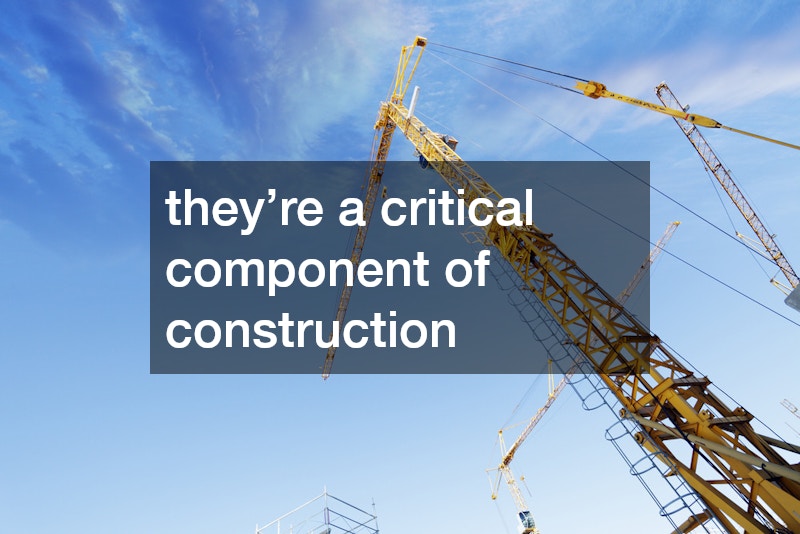Crane rentals are a vital part of modern construction projects. Choosing the right crane can dramatically affect timelines, budgets, and safety. This guide offers contractors key insights into selecting, budgeting, and safely operating rental cranes, ensuring streamlined and efficient project execution.
Exploring Common Crane Types
Mobile Cranes
Mobile cranes are among the most versatile rental options. Mounted on wheeled chassis or trucks, they are designed for mobility and quick setup.
Ideal for sites with limited space or short-term lifting needs, they are frequently used in road construction, infrastructure upgrades, and maintenance work.
Their ability to handle various loads and heights makes them a flexible solution across project types. However, contractors should evaluate specific lift requirements—including boom length and weight capacity—before choosing a mobile crane.
Tower Cranes
Tower cranes are the backbone of high-rise construction. Their tall structure and heavy lifting ability make them suitable for transporting steel beams, concrete panels, and large mechanical units. With 360-degree rotation and customizable jib lengths, they can cover wide areas without moving their base.
Despite their utility, tower cranes require careful planning, including zoning approvals, installation logistics, and consideration of wind conditions. Their high efficiency justifies the additional prep work, especially for large-scale vertical projects.
Rough Terrain Cranes
Rough terrain cranes are built for off-road environments. With four-wheel drive and large tires, they’re suited for rugged sites such as pipelines, mining zones, or mountainous terrain. They combine strength and agility, capable of lifting heavy materials in challenging conditions.
These cranes often include telescoping booms for added height and reach. Contractors working in remote or undeveloped areas benefit most from this crane type. However, careful site assessment is essential to avoid performance issues due to terrain irregularities.
Selecting the Right Crane for the Job
Assessing Project Requirements
Proper crane selection begins with a clear understanding of the project scope. Key considerations include load weight, lift height, and frequency of crane use. Heavier, repetitive lifts over long durations may warrant a more robust crane, while infrequent, lighter lifts could justify smaller models.
Partnering with engineers during the planning phase can help match crane specifications to the structural and logistical needs of the project. Doing so prevents costly mismatches and supports smooth operations.
Evaluating Site Conditions
Terrain, access points, and surrounding structures all influence crane suitability. Uneven or unstable ground may require additional equipment like stabilizers or mats. Likewise, cranes must be able to navigate and set up within the site’s physical limitations.
Weather also plays a role. Wind speeds, rainfall, and temperature shifts can affect crane operation. Choosing a crane compatible with these conditions reduces downtime and increases safety.
Comparing Rental Offers
Not all crane rental agreements are equal. While base rates matter, contractors should also evaluate service levels, equipment condition, and support. Check maintenance records and request recent inspection reports to ensure reliability.
Be clear on what’s included in the contract—operator fees, fuel, delivery, and setup are often separate. A detailed quote allows contractors to make apples-to-apples comparisons and avoid unexpected charges.
Estimating Crane Rental Costs
Understanding Rental Rates
Rental rates vary depending on crane type, size, and usage duration. Rates may be hourly, daily, or weekly, with longer commitments typically offering cost savings. It’s important to consider total time on site—not just operational hours—including setup and dismantling.
Researching average market rates in your region helps set realistic budget expectations and identifies opportunities for negotiation, especially during slower seasons.
Accounting for Additional Fees
Many crane rentals come with hidden costs. Common fees include delivery, operator certification, insurance, permits, and fuel surcharges. If the crane requires specialized assembly or support personnel, those charges should be anticipated upfront.
Late returns or damage may also incur penalties. Clear communication with the rental company and a thorough contract review ensure there are no surprises.
Budgeting for Long-Term Projects
Extended projects require a broader budgeting approach. Beyond rental fees, long-term usage demands continual assessments. Will the crane still meet the project’s needs as phases progress? Will weather, logistics, or engineering changes require different equipment?
Having a flexible yet comprehensive budget allows contractors to adapt without financial setbacks. Planning for contingencies is part of smarter crane rental strategy.
Meeting Crane Safety Standards
Complying with OSHA Regulations
Safety should be a top priority on any job site. OSHA’s crane operation standards are designed to prevent accidents and injuries. These rules cover operator training, load testing, inspections, and fall protection systems.
Familiarizing your team with relevant OSHA guidelines promotes a safety-first culture and helps avoid fines or delays caused by violations. Proper recordkeeping can also support compliance and insurance claims if needed.
Verifying Certification Requirements
Only certified operators should handle cranes. Certification ensures operators understand safety procedures, equipment limitations, and emergency protocols. Contractors must confirm that rental agreements include properly trained personnel or budget for hiring qualified operators.
Ongoing certification tracking is just as important. Many certifications require renewal every few years, and staying current demonstrates a commitment to professional safety standards.
Establishing On-Site Safety Protocols
Even with certified equipment and personnel, on-site procedures are vital. Assigning responsibilities, such as designating a signal person or lift director, helps maintain coordination and reduce risk. Pre-lift meetings, hazard assessments, and site inspections should be part of daily operations.
Posting visual safety guides and reinforcing training through toolbox talks or safety drills can enhance awareness. When safety is treated as an integral part of workflow—not an afterthought—crane operations run smoother and more efficiently.
Crane rentals are more than a line item on a project budget—they’re a critical component of construction planning and execution. By understanding different crane types, evaluating site-specific needs, comparing rental providers, and prioritizing safety, contractors can make smarter rental decisions that save time, reduce risk, and improve outcomes. A proactive and informed approach ensures that every lift contributes to project success.

